Abstract
Flagellin (molecular weight 40,000) from Salmonella adelaide was reacted with CNBr to give mainly four peptide fragments, A, B, C and D, the largest of which (fragment A, molecular weight 18,000) retained all the serological activity of flagellin itself. Mixtures of the fragments or individual fragments were injected into neonatal or adult rats, either as a single dose in saline or in adjuvant, or in multiple doses in saline. Antibody titres, measured by bacterial immobilization, were compared with those given after an injection of flagellin. Fragment A and the complete CNBr digest of flagellin (the `digest') were both immunologically active whereas fragments B, C and D were inactive.
When given as a single injection in saline into adult rats, the `digest' or fragment A was much less efficient than flagellin at inducing either a primary antibody response or the production of primed cells for a secondary antibody response. In contrast, the `digest' or fragment A was effective at triggering primed cells to give a secondary antibody response. These findings were consistent with an interpretation given in detail elsewhere relating to `in vivo' localization of labelled flagellin and fragment A in rat lymph nodes to the immune response. Fragment A and flagellin were equally immunogenic when injected in Freund's complete adjuvant.
Rats given a course of injection of the `digest' starting on the day of birth became almost completely tolerant to either flagellin or polymerized flagellin. Daily injections of the `digest' or fragment A for 4 weeks or longer into adult rats resulted in a significant degree of tolerance to flagellin and to polymerized flagellin. Adult rats made tolerant in this way responded normally to BSA injected in Freund's complete adjuvant and to a slightly decreased extent to sheep RBC.
It was concluded that by a process of partial degradation, a highly immunogenic substance, polymerized flagellin, had been converted into a preparation with strong tolerance-inducing properties. The relevance of this approach to transplantation antigens was discussed.
Full text
PDF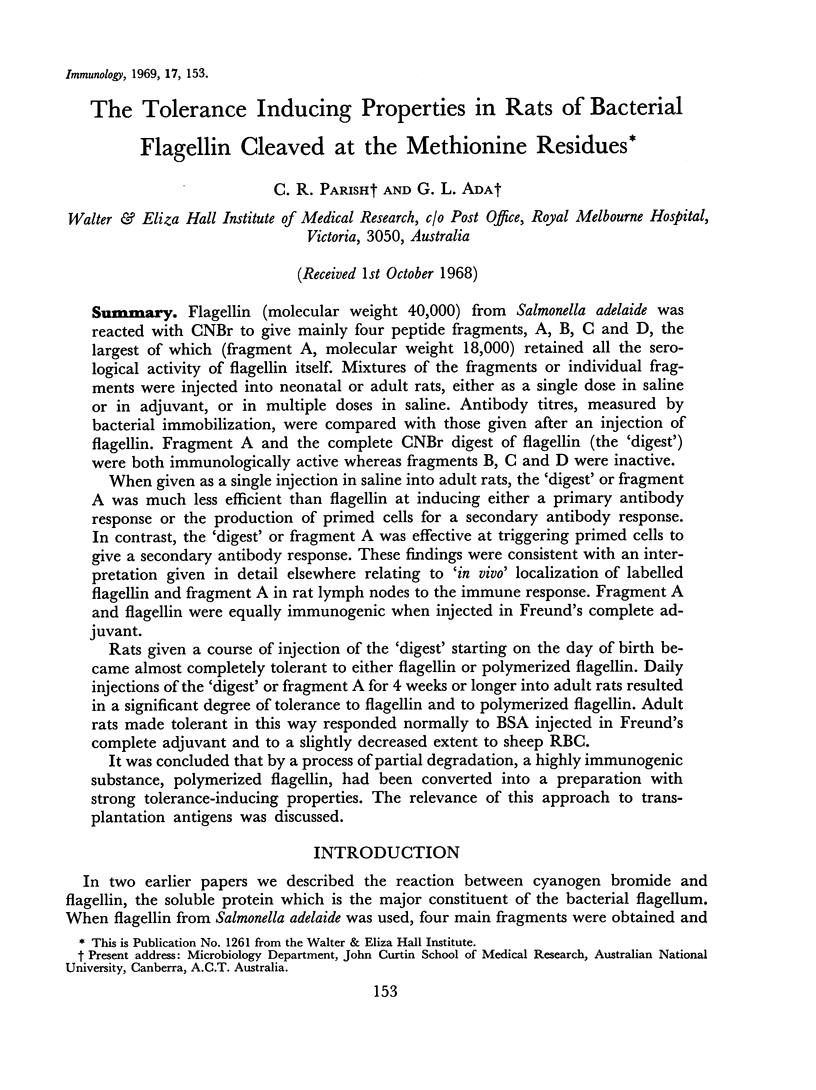
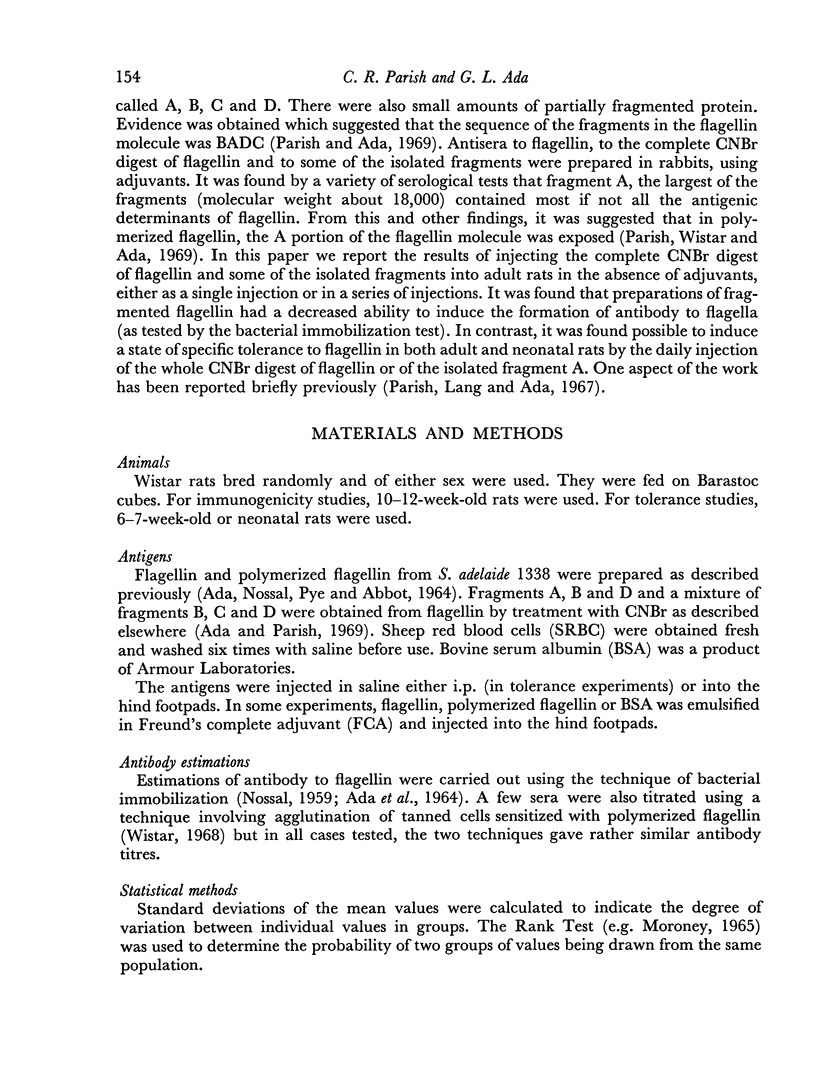
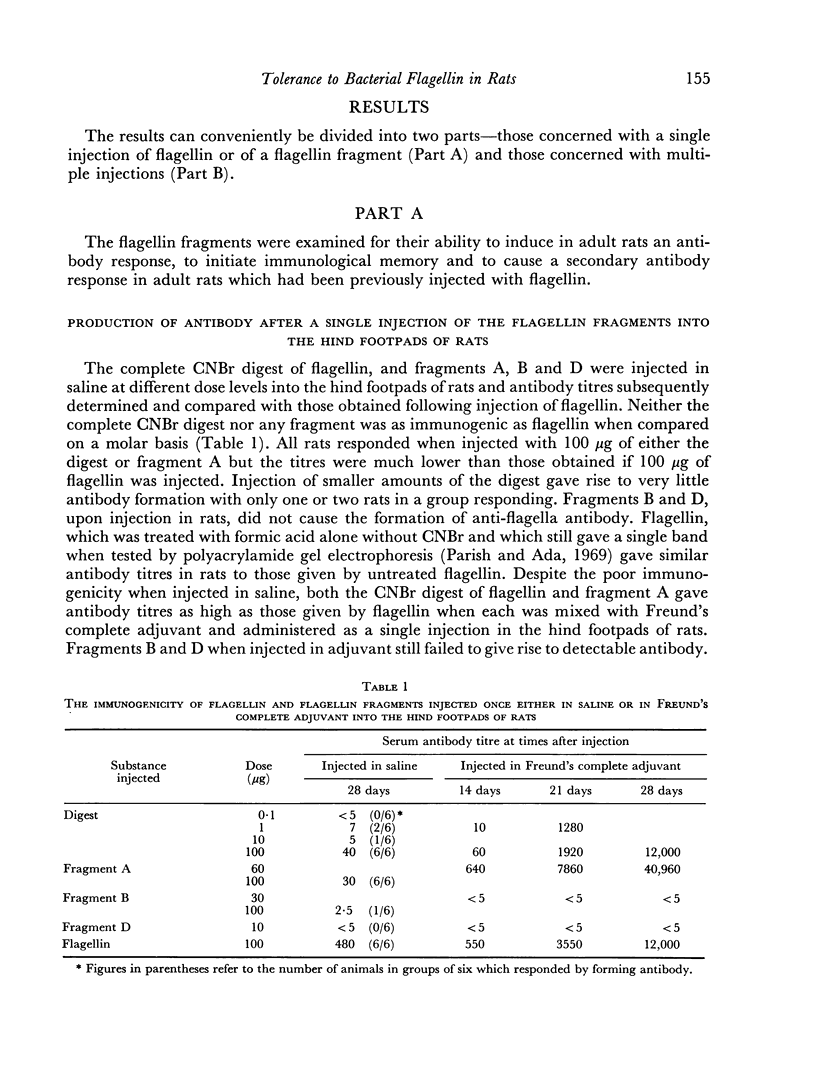
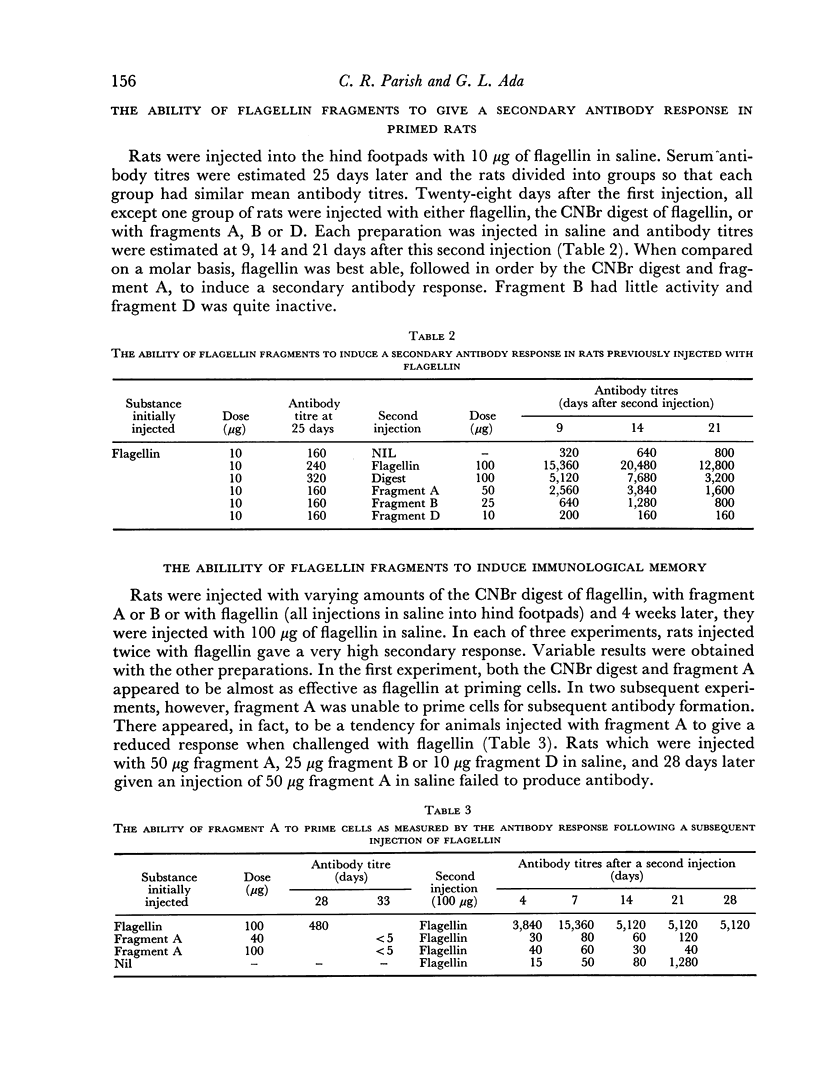
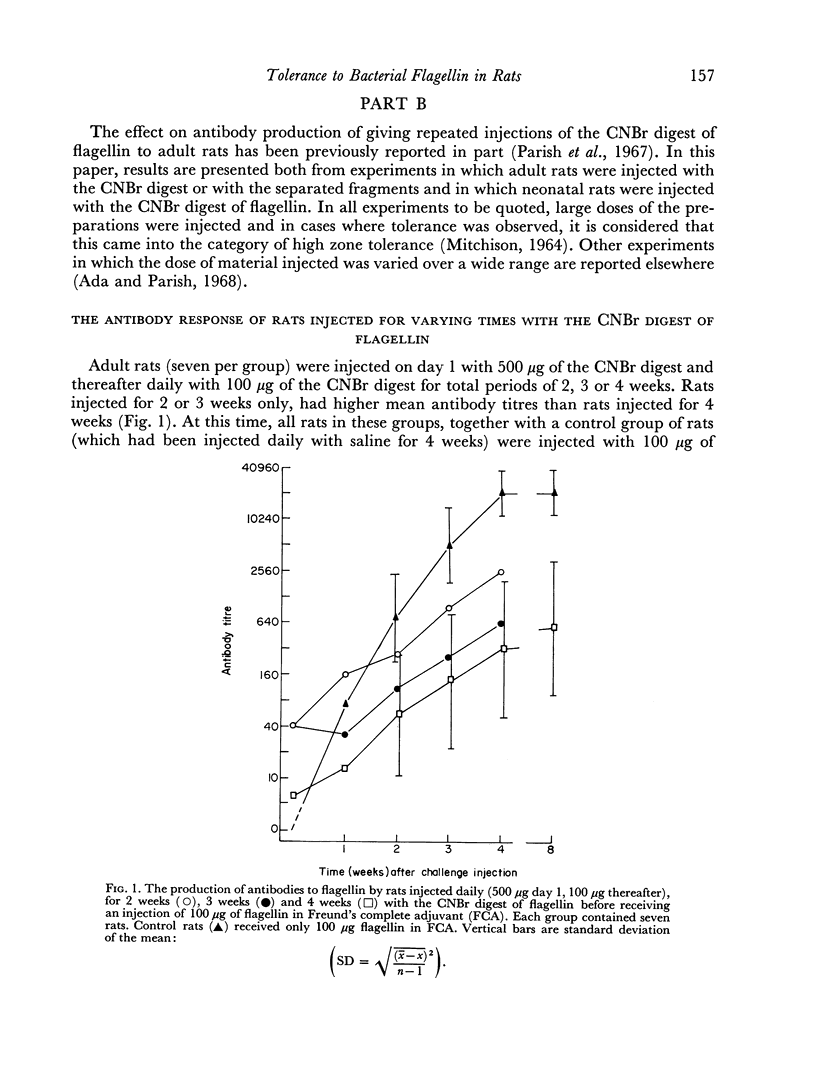
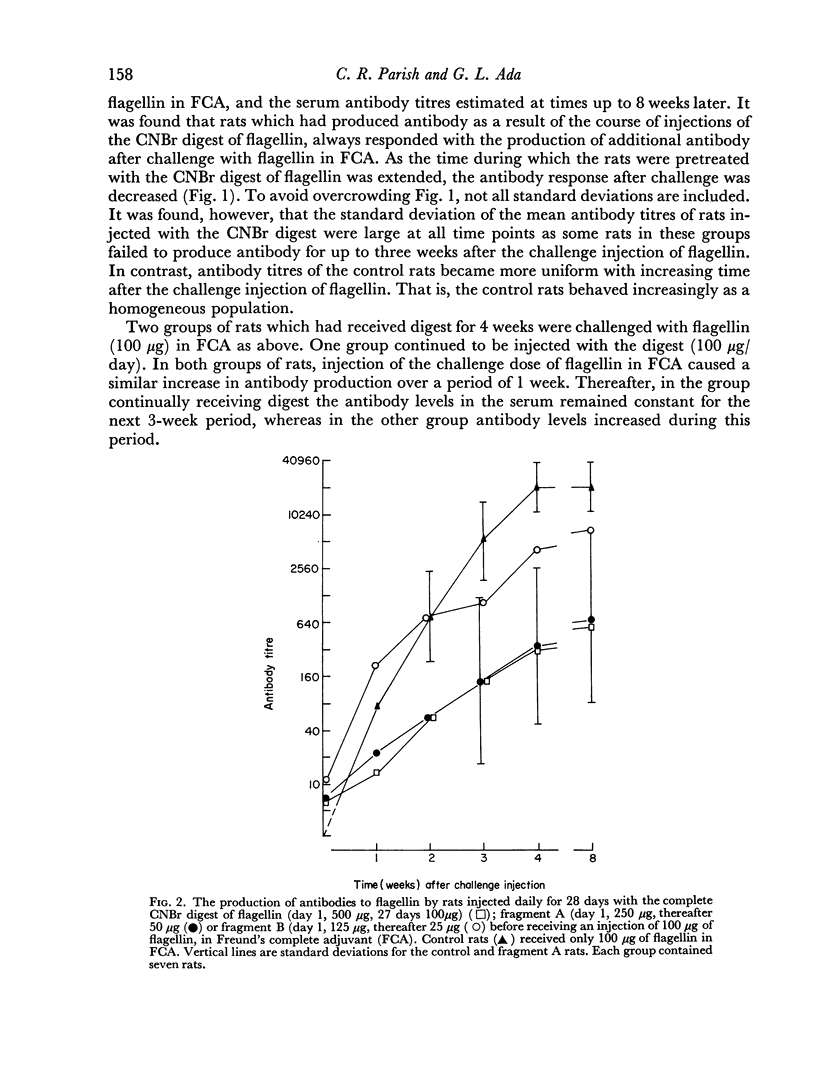
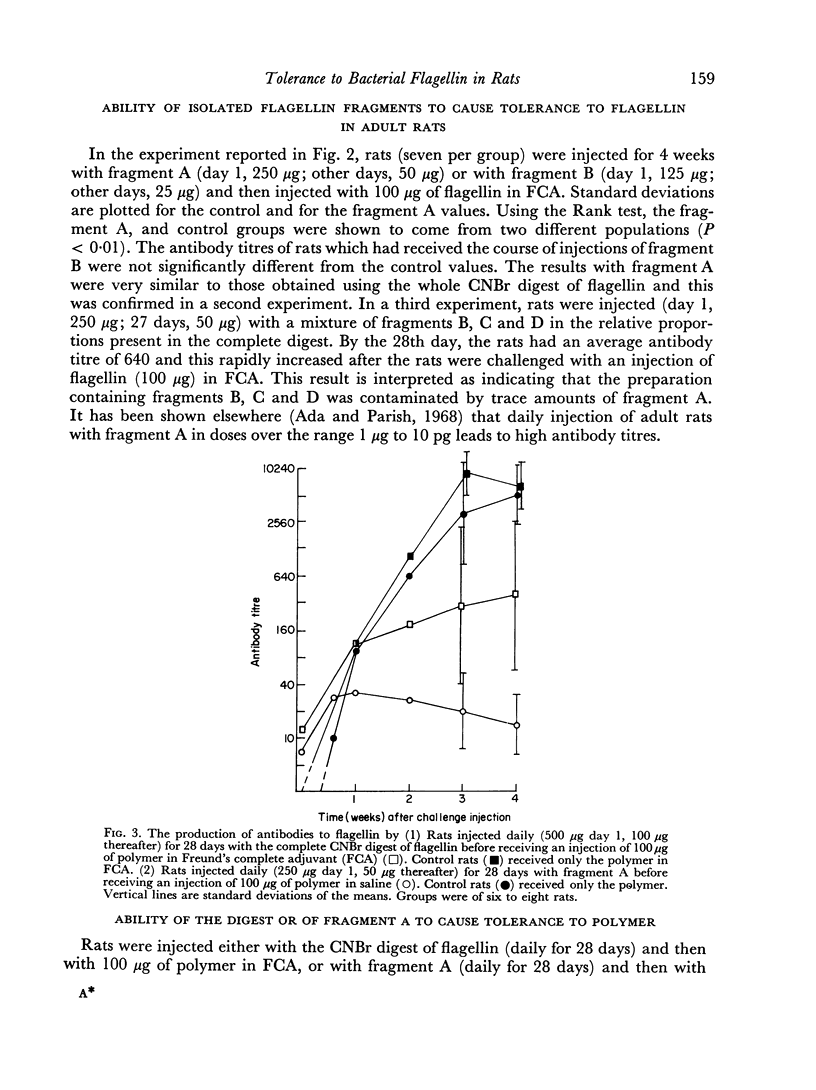
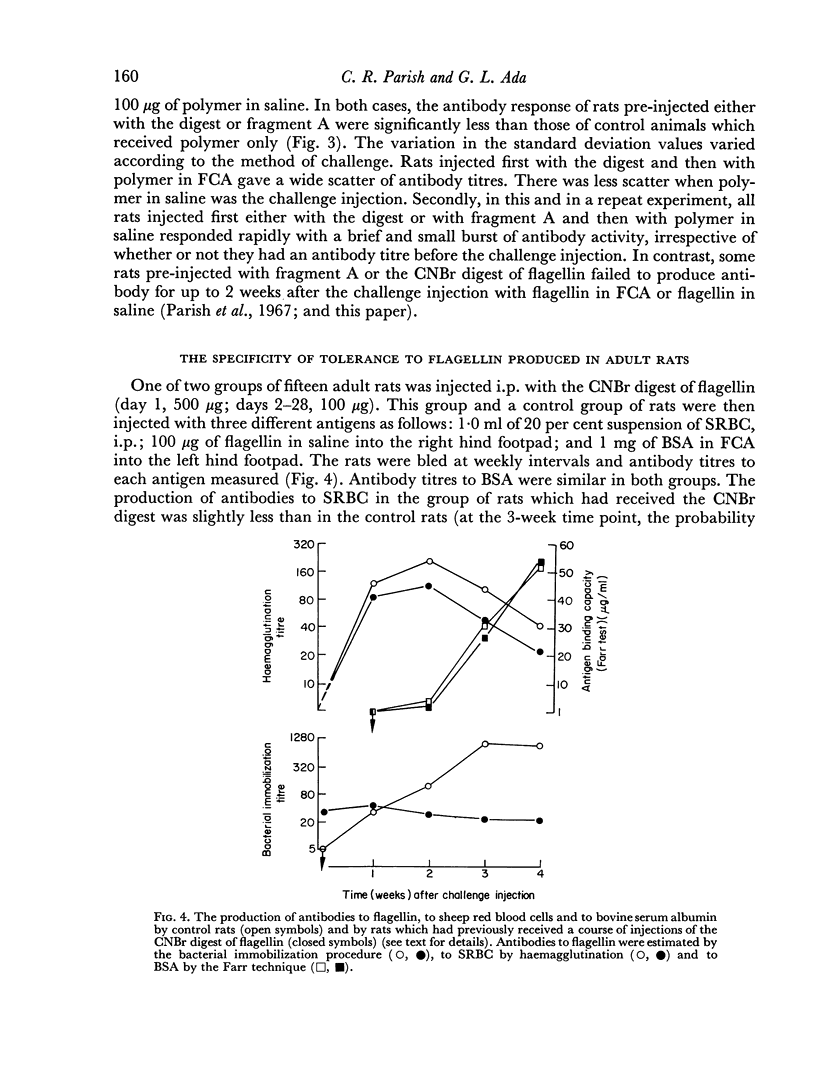
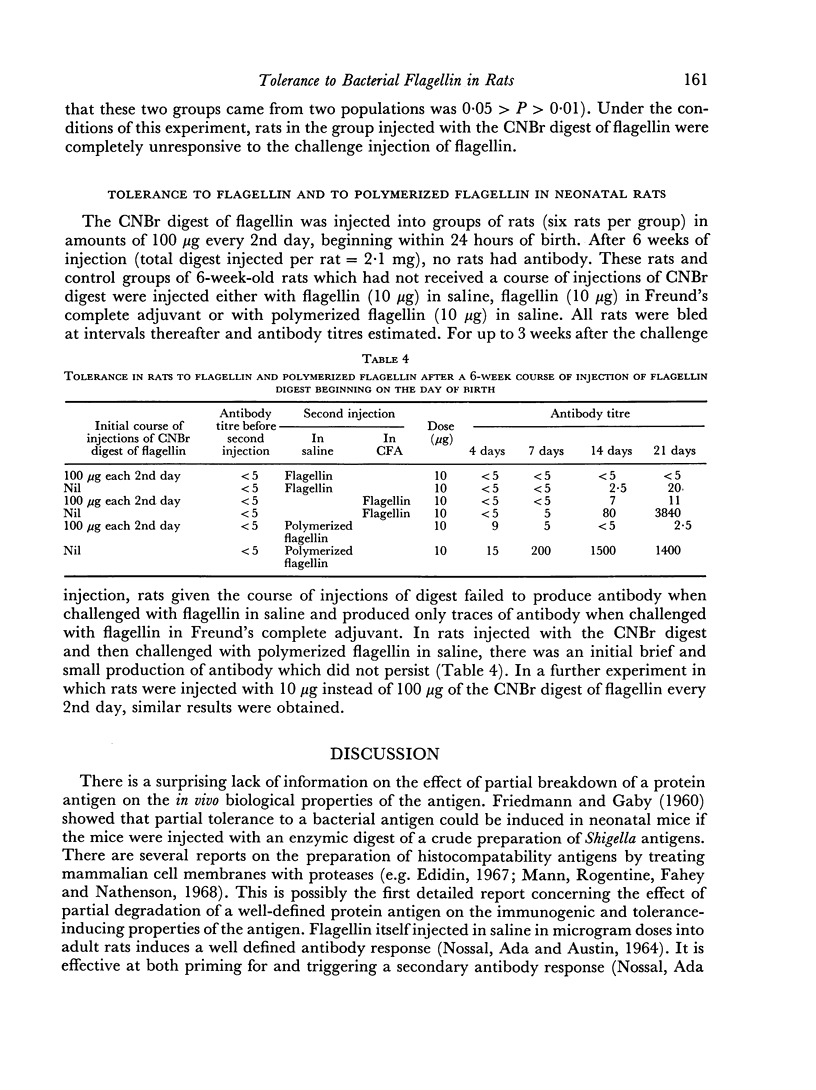
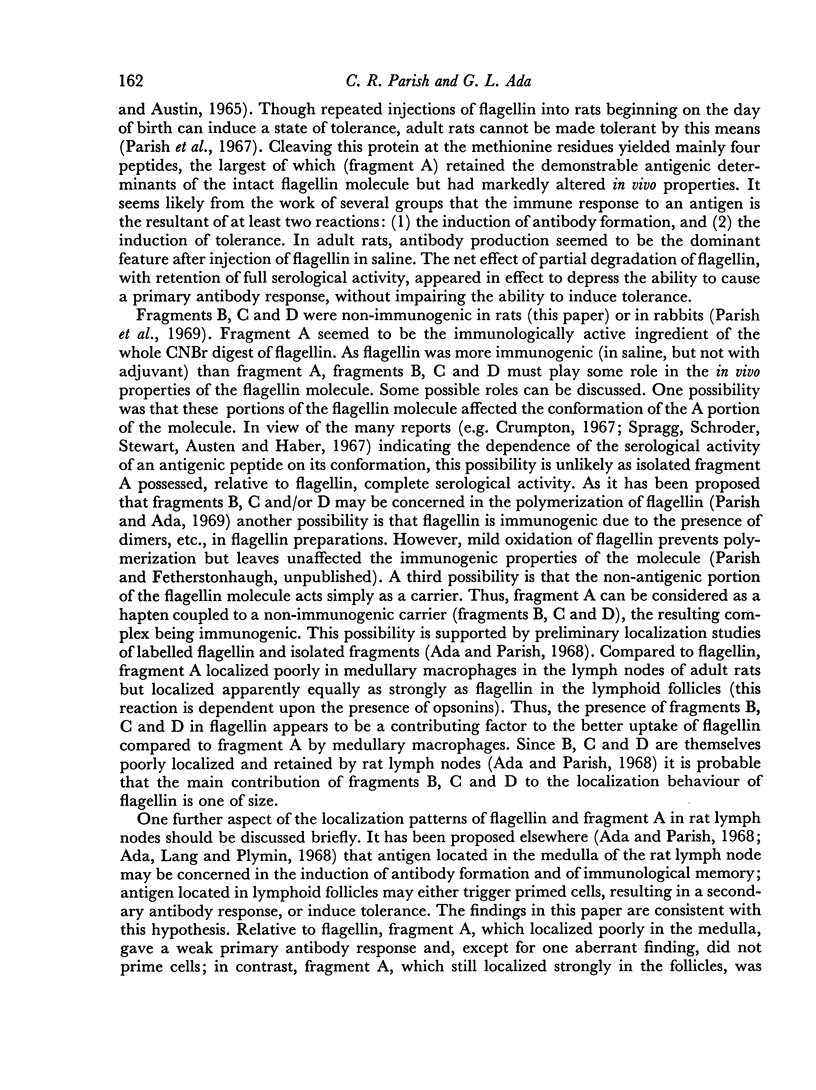
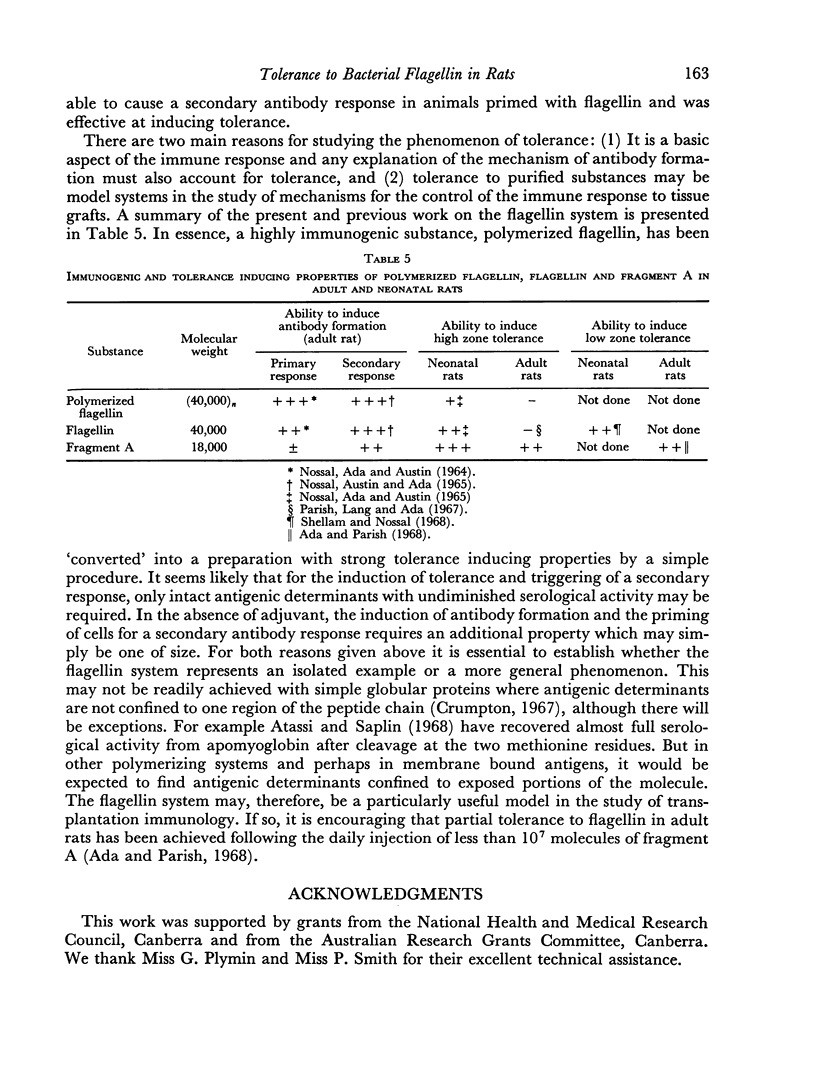
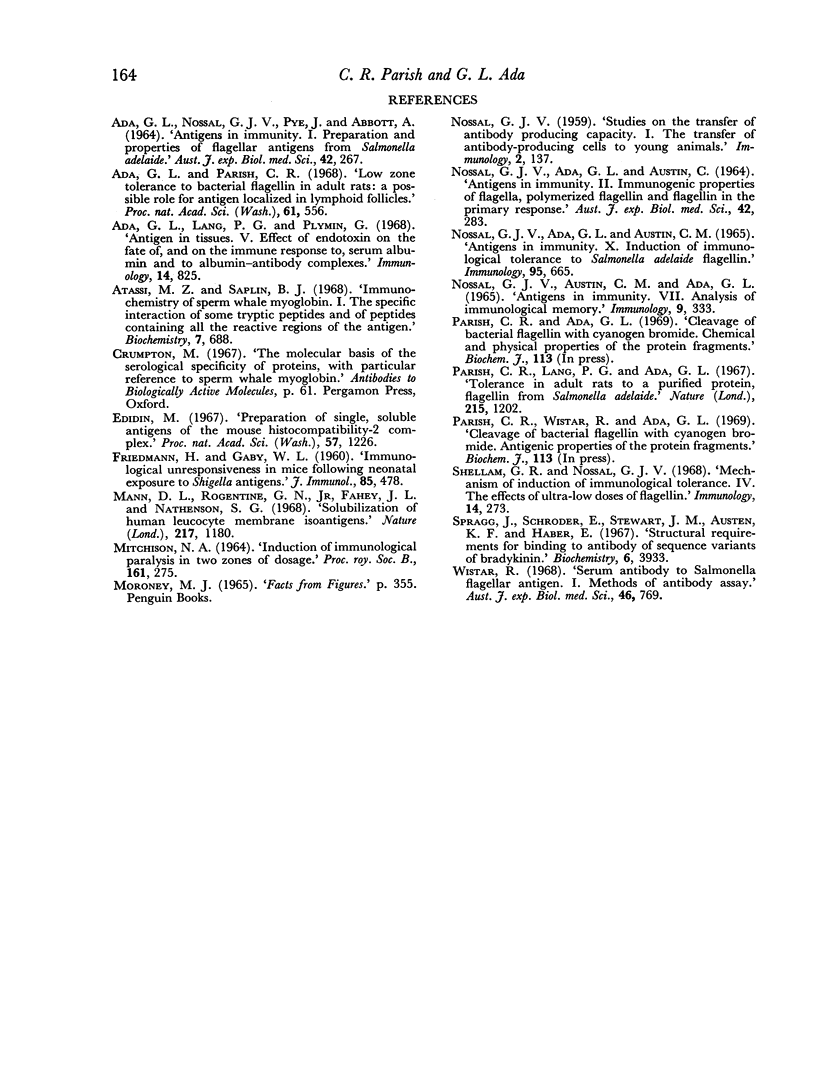
Selected References
These references are in PubMed. This may not be the complete list of references from this article.
- ADA G. L., NOSSAL G. J., PYE J., ABBOT A. ANTIGENS IN IMMUNITY. I. PREPARATION AND PROPERTIES OF FLAGELLAR ANTIGENS FROM SALMONELLA ADELAIDE. Aust J Exp Biol Med Sci. 1964 Jun;42:267–282. [PubMed] [Google Scholar]
- Ada G. L., Lang P. G., Plymin G. Antigen in tissues. V. Effect of endotoxin on the fate of, and on the immun response to, serum albumin and to albumin-antibody complexes. Immunology. 1968 Jun;14(6):825–836. [PMC free article] [PubMed] [Google Scholar]
- Ada G. L., Parish C. R. Low zone tolerance to bacterial flagellin in adult rats: a possible role for antigen localized in lymphoid follicles. Proc Natl Acad Sci U S A. 1968 Oct;61(2):556–561. doi: 10.1073/pnas.61.2.556. [DOI] [PMC free article] [PubMed] [Google Scholar]
- Atassi M. Z., Saplin B. J. Immunochemistry of sperm whale myoglobin. I. The specific interaction of some tryptic peptides and of peptides containing all the reactive regions of the antigen. Biochemistry. 1968 Feb;7(2):688–698. doi: 10.1021/bi00842a026. [DOI] [PubMed] [Google Scholar]
- Edidin M. Preparation of single, soluble antigens of the mouse histocompatibility-2 complex. Proc Natl Acad Sci U S A. 1967 May;57(5):1226–1231. doi: 10.1073/pnas.57.5.1226. [DOI] [PMC free article] [PubMed] [Google Scholar]
- FRIEDMAN H., GABY W. L. Immunologic unresponsiveness in mice following neonatal exposure to Shigella antigens. J Immunol. 1960 Nov;85:478–482. [PubMed] [Google Scholar]
- MITCHISON N. A. INDUCTION OF IMMUNOLOGICAL PARALYSIS IN TWO ZONES OF DOSAGE. Proc R Soc Lond B Biol Sci. 1964 Dec 15;161:275–292. doi: 10.1098/rspb.1964.0093. [DOI] [PubMed] [Google Scholar]
- Mann D. L., Rogentine G. N., Jr, Fahey J. L., Nathenson S. G. Solubilization of human leucocyte membrane isoantigens. Nature. 1968 Mar 23;217(5134):1180–1181. doi: 10.1038/2171180a0. [DOI] [PubMed] [Google Scholar]
- NOSSAL G. J., ADA G. L., AUSTIN C. M. ANTIGENS IN IMMUNITY. II. IMMUNOGENIC PROPERTIES OF FLAGELLA, POLYMERIZED FLAGELLIN AND FLAGELLIN IN THE PRIMARY RESPONSE. Aust J Exp Biol Med Sci. 1964 Jun;42:283–294. [PubMed] [Google Scholar]
- NOSSAL G. J. Studies on the transfer of antibody-producing capacity. I. The transfer of antibody-producing cells to young animals. Immunology. 1959 Apr;2(2):137–147. [PMC free article] [PubMed] [Google Scholar]
- Nossal G. J., Ada G. L., Austin C. M. Antigens in immunity. X. Induction of immunologic tolerance to Salmonella adelaide flagellin. J Immunol. 1965 Oct;95(4):665–672. [PubMed] [Google Scholar]
- Nossal G. J., Austin C. M., Ada G. L. Antigens in immunity. VII. Analysis of immunological memory. Immunology. 1965 Oct;9(4):333–348. [PMC free article] [PubMed] [Google Scholar]
- Parish C. R., Lang P. G., Ada G. L. Tolerance in adult rats to a purified protein, flagellin, from Salmonella adelaide. Nature. 1967 Sep 9;215(5106):1202–1203. doi: 10.1038/2151202a0. [DOI] [PubMed] [Google Scholar]
- Shellam G. R., Nossal G. J. Mechanism of induction of immunological tolerance. IV. The effects of ultra-low doses of flagellin. Immunology. 1968 Feb;14(2):273–284. [PMC free article] [PubMed] [Google Scholar]
- Spragg J., Schröder E., Stewart J. M., Austen K. F., Haber E. Structural requirements for binding to antibody of sequence variants of bradykinin. Biochemistry. 1967 Dec;6(12):3933–3941. doi: 10.1021/bi00864a040. [DOI] [PubMed] [Google Scholar]
- Wistar R., Jr Serum antibody to Salmonella flagellar antigens. I. Methods of antibody assay. Aust J Exp Biol Med Sci. 1968 Dec;46(6):769–777. doi: 10.1038/icb.1968.183. [DOI] [PubMed] [Google Scholar]


